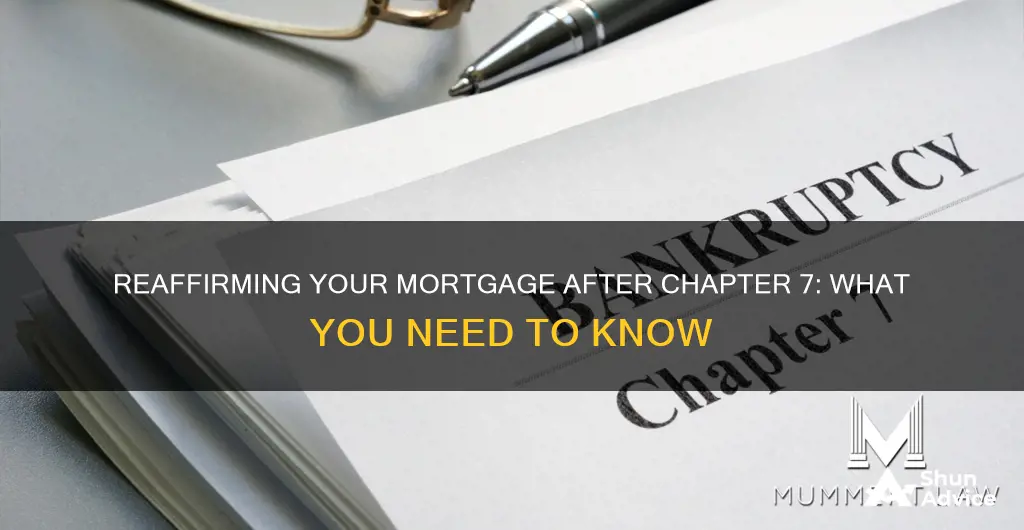
Chapter 7 bankruptcy allows you to wipe out your personal liability on all dischargeable debts, including your mortgage. However, if you want to keep your property, you may need to reaffirm your mortgage debt. A reaffirmation agreement is a legal document that binds you to repay secured debt, and most Chapter 7 debtors will reaffirm debt for high-value items such as cars, boats, or RVs. While it is possible to reaffirm your mortgage debts, it is not necessary, and bankruptcy attorneys rarely advise their clients to do so.
| Characteristics | Values |
|---|---|
| What is a reaffirmation agreement? | A legal document that binds a debtor to repay secured debt. |
| Who sends the reaffirmation agreement? | The secured creditor or bankruptcy attorney. |
| Who reviews the reaffirmation agreement? | A bankruptcy lawyer or a bankruptcy judge. |
| What is the purpose of a reaffirmation agreement? | To keep the collateral, i.e., to remain in possession of one's property. |
| What is the benefit of a reaffirmation agreement? | It enables debtors to rebuild their credit score sooner. |
| What is the drawback of a reaffirmation agreement? | It makes debtors personally liable for the debt, even after a discharge. |
| What is the risk of not signing a reaffirmation agreement? | The creditor can repossess the collateral following the closure of the Chapter 7 Bankruptcy case. |
| What is the benefit of not signing a reaffirmation agreement? | The debtor can walk away from the property with no personal liability for the mortgage. |
What You'll Learn

Reaffirming mortgage debt is not necessary
Secondly, signing a reaffirmation agreement puts you back on the hook for the full amount of the debt. If you sign the agreement, you are liable for the debt, and the bank can sue you personally if you default. If you do not sign, the bank will have a "security deed" attached to the property, allowing them to foreclose if you fall behind on payments, but they cannot sue you personally.
Thirdly, reaffirmation agreements are always subject to court approval. Judges decide whether to approve these agreements, and their stance depends on the state. Some mortgage lenders may refuse to refinance without a reaffirmation agreement, but this may violate the stay on collections that comes with a bankruptcy discharge.
Finally, there is little risk of the lender foreclosing on your property as long as you make your monthly mortgage payments on time and in full. Foreclosure is an expensive procedure for mortgage lenders, so keeping up with your payments should allow you to stay in your house.
Remember, it is important to speak with a lawyer to determine if reaffirmation is right for your specific situation.
Understanding Mortgage Debt: Strategies for Homeowners
You may want to see also

Pros and cons of reaffirming mortgage debt
Pros
Reaffirming mortgage debt can have several advantages, including:
- It allows you to keep your home, even if you are unable to make payments in the future.
- It can help improve your credit score by ensuring that your lender reports your payments to credit bureaus.
- It may provide an opportunity to negotiate more favourable terms, such as a lower interest rate or a reduced principal balance.
- It can give you peace of mind knowing that you are fulfilling your contractual obligations and maintaining a positive relationship with your lender.
Cons
However, there are also some potential disadvantages to consider:
- If you reaffirm your mortgage debt and subsequently default on payments, you may be personally liable for the deficiency balance, and the lender may sue you or garnish your wages and bank accounts.
- Reaffirmation agreements may not always be necessary to keep your home. In many cases, lenders will not foreclose as long as they continue receiving timely payments, even without a reaffirmation agreement.
- Reaffirming mortgage debt may not be in your best interest if you are struggling financially, as it adds an additional burden and increases the risk of future complications.
- It may limit your flexibility, as you are committing to a new contract with specific terms and conditions.
- There is a risk that you may not be able to afford the payments, leading to potential foreclosure and further financial difficulties.
Making Mortgage Payments: Wells Fargo Guide
You may want to see also

What happens if you don't reaffirm
If you don't reaffirm your mortgage after Chapter 7 bankruptcy, you will no longer be personally liable for the mortgage. This means that you can walk away from the property without any personal liability for the remaining balance. However, the lender can still repossess or foreclose on the property if you default on the loan or stop making payments.
In the case of a Chapter 7 bankruptcy discharge, the automatic stay that temporarily stops creditors from taking collection action is replaced by a permanent protection. This means that creditors can no longer hound you, and you are legally protected from their collection actions. You can even sue creditors who try to collect on discharged debts.
If you don't reaffirm your mortgage, your lender may not report your payments to the credit bureaus, and this may not help rebuild your credit score following your bankruptcy. Additionally, without a reaffirmation agreement, you may not be able to refinance with a different lender, as they may not give as much weight to your payment history as they would to a credit bureau's history of payments.
It's important to note that even if you don't reaffirm, your lender will usually let you keep the property as long as you make timely payments on the loan. However, they can repossess your property at any time if you don't reaffirm, and there is no way to prevent this without a contract. Therefore, if you can't afford to lose the property, the benefit of walking away may not be worth the risk.
Overall, the decision to reaffirm a mortgage after Chapter 7 bankruptcy depends on various factors, including your financial situation, the value of your property, and your ability to make timely payments. It is always recommended to seek legal advice to understand your options and make an informed decision.
Re-amortizing Your Mortgage: A Guide to Refinancing Your Home Loan
You may want to see also

How to reaffirm your mortgage
A reaffirmation agreement is a legal document that binds a debtor to repay secured debt. In the context of a mortgage, a reaffirmation agreement confirms a person's responsibility for paying their mortgage debt, even after the discharge of other debts. This means that if you reaffirm your mortgage and continue to make monthly payments, the lender will report the account as current to credit bureaus, which can help you rebuild your credit sooner.
- Consult a bankruptcy lawyer: Before entering into any agreement, it is essential to seek legal advice. A bankruptcy lawyer can review the reaffirmation agreement and ensure it is in your best interest. They can also advise you on the potential risks and benefits of reaffirming your mortgage.
- Understand the risks: Reaffirmation agreements keep filers personally liable for making mortgage payments, even after a discharge. This means that if you default on your payments, the lender can sue you personally and garnish your wages and bank accounts to collect the money. There is also a risk that you may be obligated to pay a large balance on the mortgage obligation.
- Negotiate new terms: When you reaffirm a debt, you are signing a new contract. This gives you the opportunity to negotiate more favorable terms, such as a lower interest rate or a reduced principal balance. However, lenders are not required to offer these benefits, and in most cases, the terms remain the same.
- Sign the reaffirmation agreement: If you decide to proceed, you will need to sign the reaffirmation agreement. This agreement will override the discharge, and you will remain liable for the debt even after the closure of your bankruptcy case. Keep in mind that you have 60 days to rescind the agreement if you change your mind.
- Continue making timely payments: Once the reaffirmation agreement is in place, it is crucial to stay current on your mortgage payments. As long as you make your payments on time and in full, there is little risk of the lender foreclosing on your property.
It is important to note that reaffirming your mortgage is not a requirement, and there may be alternative options available. Some lenders may be willing to work with you without a reaffirmation agreement, especially if you are making timely payments. Additionally, bankruptcy attorneys rarely authorize their clients to execute a reaffirmation agreement on a mortgage obligation. Therefore, it is essential to weigh the pros and cons carefully before making a decision.
Exploring Options: Strategies to Temporarily Pause Mortgage Payments
You may want to see also

What is a reaffirmation agreement
A reaffirmation agreement is a legally binding contract between a debtor and a creditor during a Chapter 7 bankruptcy proceeding. It allows the debtor to voluntarily commit to repaying a specific debt that would otherwise be discharged through the bankruptcy process. This type of agreement is typically used to retain essential assets, such as a car or home, that would otherwise be repossessed or foreclosed upon.
Reaffirmation agreements are not required during bankruptcy and may not be suitable for everyone. However, they can be a strategic decision for debtors who want to keep their property. By entering into a reaffirmation agreement, debtors can continue making payments and avoid repossession or foreclosure. It also helps to rebuild their credit score after bankruptcy, as creditors are more likely to report it positively to the credit bureaus.
To request a reaffirmation agreement, debtors must submit a statement of intent to the court and contact the lender to establish terms. Court approval is required to ensure the debtor can reasonably afford the payments. If the debtor has an attorney, the attorney must confirm that the agreement is in the debtor's best interest and will not cause undue financial hardship. Once the agreement is approved, the debt becomes an ongoing obligation, and the debtor must continue making payments as agreed. If they default, the creditor can take legal action, such as repossessing the collateral or suing for the remaining balance.
While reaffirmation agreements can help debtors retain assets and improve their credit score, they also carry significant risk. Debtors remain liable for the total amount of the reaffirmed debt, even after the completion of their bankruptcy case. Therefore, it is important for debtors to fully understand the terms and potential consequences of a reaffirmation agreement before entering into one.
Requesting a Payoff: A Guide to Phh Mortgage
You may want to see also
Frequently asked questions
A reaffirmation agreement is a legal document that binds a debtor to repay secured debt. This means that where all debt, including secured debt, is wiped out in bankruptcy, a signing of a reaffirmation agreement puts the debtor back on the hook for the full amount of the debt.
If you do not sign a reaffirmation agreement, the bank will still have what is called a "security deed" attached to the property. That will allow the bank to foreclose if the debtor falls behind on the payments even after bankruptcy but does not allow the bank to sue the debtor personally.
Signing a reaffirmation agreement assures that your lender will continue to report your payments to the credit reporting agencies, which enables you to rebuild your credit sooner.







